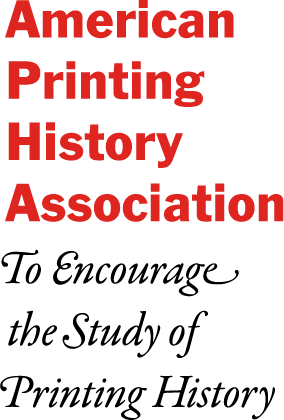Chesapeake Chapter : Paul Holbrook
Paul Holbrook Gives Informative Talk Approximately 16 chapter members and guests gathered at The Rare Book and Special Collections Division of the Library of Congress on April 26th to hear Paul Holbrook, Director of the King Library Press of the University of Kentucky, talking primarily about the uncial type designs of Victor Hammer. (On the previous day Mr. Holbrook had given a more general talk about Hammer which some chapter members had also attended.) Also, about 40 items from the library’s Victor Hammer collection were on display around the Rosenwald Room to support Mr. Holbrook’s talk. Attendees took advantage of the ample time provided to view and discuss these items.
Attendees including (around the table from left) Stan Nelson, Greg Robison, Clare Imholtz, and Doug McElrath view some of the items from the library’s Hammer Collection.
Victor Hammer (1882 to 1967) was an Austrian-born painter, sculptor, type designer, printer, and teacher who emigrated to the United States in 1939, first teaching at Wells College in Aurora, New York, and then at Transylvania College in Lexington, Kentucky.
Library of Congress reference librarian Eric Frazier introduces Paul Holbrook.
Reflecting his high standards, Hammer was not satisfied with others cutting punches for his type designs; he had to do the punch cutting himself. When designing a type he generally did not start with drawing the letterforms but instead began by cutting punches. Mr. Holbrook had mentioned that Hammer had adopted the uncial as his everyday handwriting and was therefore so familiar with the letterforms that he did not need drawings to visualize the type. Hammer believed his type should reflect the language being set and made small changes to a particular typeface to improve its fit and flow for each language. He thought the composed letters should look like a “string of pearls.” According to Hermann Zapf, Hammer was the first designer to use the uncial for text.
This correspondent was impressed by the precise presswork refected by the items on display. It was common for illustrations to be made up of very fine lines in a solid background. The fine lines stayed open while the solid background was perfectly even and dense. Another interesting technical aspect was the method Hammer used to print large two-color initials. (See photo below) Both colors were printed in one pass. The background color was inked while locked up in the press. Te initial itself was a separate piece of thin metal precisely cut to fit into the space allowed for it on the background plate.
Two-color illustrated initial with mounted printing plate for background and cutout for blue initial.
Mr. Holbrook had the opportunity to print some of these initials while he was working with Hammer’s widow, Carolyn. He would hand ink the initial and then carefully lift it with an ink or putty knife and gently place it in its proper space on the background plate for printing.
Mr. Holbrook’s reminiscences and insightful answers to questions were appreciated by those attending. Attendees received a keepsake of the occasion printed at Chris Manson’s Crooked Crow Press. Also, Mr. Holbrook provided two keepsakes and two informative handouts which supported and illustrated his talk.
Mr. Holbrook displays one of the keepsakes he brought that each attendee received; a poem entitled “Fallingwater” by George Ella Lyon, printed at the King Library Press.
We would like to thank Mr. Holbrook and the library’s staff, especially Eric Frazier, for their efforts to provide this unique opportunity for chapter members to get an in-depth understanding of Hammer’s typefaces and the library’s collection. Tanks also to Chris Manson for coordinating this event for our chapter.
Paul Holbrook (left) chats with Chris Manson before his presentation.
